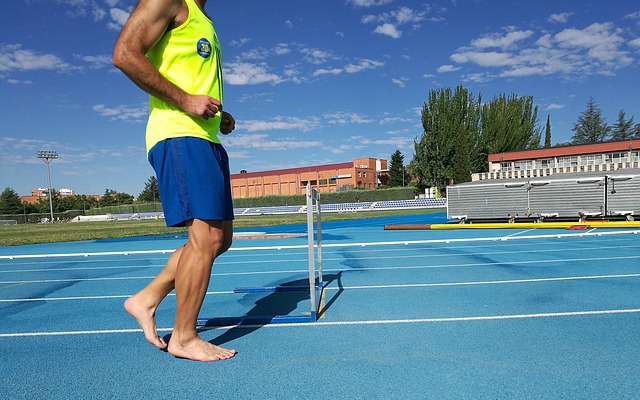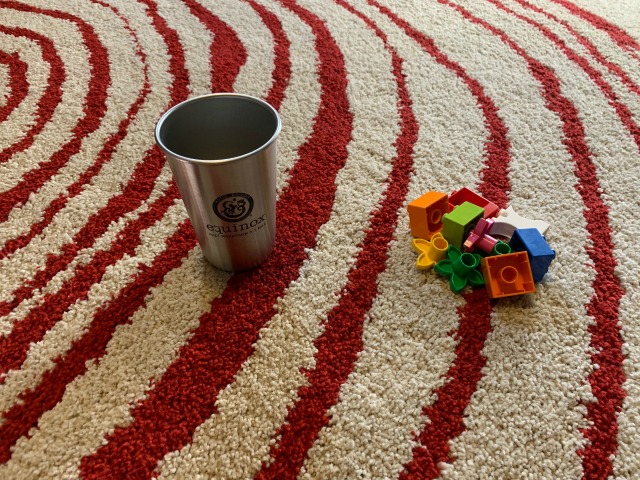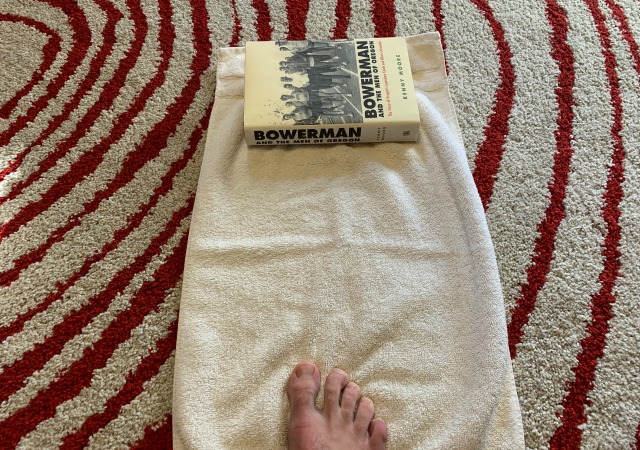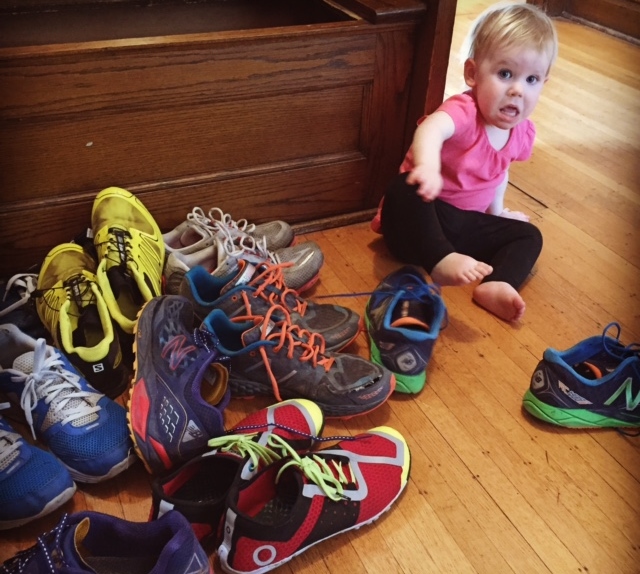Our feet are marvels of biological engineering. And we put them through hell every time we go running.

The human foot has more than 20 muscles, 26 bones, 33 joints, and hundreds of tendons and ligaments. If you happen to have problems with foot pain or injuries, foot strengthening exercises may be the difference between healthy and painful running.
That’s because our feet need to be strong to withstand the trauma of running.
Every time our foot touches down on the ground, we absorb anywhere from 2-4 times our bodyweight. That means a 150-pound runner, depending on his running pace, might exert upwards of 600 pounds of force on his feet with every foot strike.
However, other sources have put this figure at upwards of 7 or even 12 times your bodyweight.
Regardless of the exact number, we can recognize that our feet bear the burden of a tremendous amount of impact force.
Next, consider that four of the most common running injuries are:
These injuries all involve the foot. Any injury prevention approach that’s used in your training should focus on foot strengthening exercises and foot health to prevent these common problems.
But, foot strengthening exercises for runners aren’t needed by everyone. If you don’t have a history of chronic foot injuries, scroll down to the ‘Developing Foot Strength While Running’ section below.
You can also listen to episode 322 of the Strength Running Podcast. It includes a lengthy conversation with strength coach Keith Mueller that focuses on:
- The differences between pronation and supination (and whether these are bad things)
- Ideal foot strengthening exercises for runners
- The pros and cons of barefoot running
Let’s now discover who is the ideal candidate for a more robust foot strengthening program.
Who Needs Foot Strengthening?
Runners in most need of foot strengthening are those who experience a lot of foot injuries.
If you find yourself getting arch strains, plantar fasciitis, Achilles problems, peroneal tendon pain, or posterior tibial tendinitis then you should start incorporating some foot strengthening exercises into your weekly training.
Even if you don’t get injured in your feet regularly, many runners often feel pain or excessive soreness in their feet after long runs or hard workouts. If you feel like your feet are your “weak link” then it’s a smart idea to work on this weakness.
With all those impact forces traumatizing your feet with every foot strike, it’s important to go on offense and start soon.
This will help strengthen the muscles, toughen the connective tissues, and begin the process of building more durable feet.
Poor Foot Strength = Injuries

Clearly, weak feet will become injured feet sooner or later. During my running career, I had a long relationship with various foot injuries:
- An arch strain in 2002 (serious) and 2006 (minor)
- Achilles tendinopathy in 2003 (serious), 2005 (minor), and 2014 (moderate)
- Plantar fasciitis in 2004
All these feet injuries led me to the college’s Athletic Trainer, several massage therapists, and a half dozen physical therapists. They were all adamant that I include some foot strengthening exercises for runners.
But the solution wasn’t just strength work.
I also had to revise my training. The way in which I was structuring my running led me to get plenty of injuries. My training errors were:
- Not utilizing a dynamic warm-up before I started running
- Starting each run too fast instead of ramping up the intensity more gradually
- Skipping my strength training
- Too little barefoot running
- Not wearing racing shoes for workouts often enough
Over time, I gradually worked on all these mistakes. And over time, I got injured less and less.
The suggestions in this article for reducing your risk of an injury, foot strengthening exercises for runners, and training strategies for healthier feet are the result of my experience and training.
You’ll see strategies I learned from my coaches, physical therapists, and trainers. I hope they help you, too.
Foot Strengthening Exercises for Runners
If you’re ready to start a series of strength exercises for your feet, let’s start with easier options. All of these exercises have been prescribed to me by physical therapists that I’ve visited over the years.
Moving Marbles Foot Strengthening Exercise

The first exercise promotes strength but also dexterity, coordination, and mobility. And it’s both easy and fun!
First, lay out about 20 small objects on the ground. Things like marbles, Legos, or stones work really well.
Next, put a plastic cup (probably best not to choose a glass cup!) next to your pile of small objects.
The objective is to pick up the items with your toes and place them in the cup. Once you get all of them in the cup, dump it out and repeat this “game” once or twice.
Many runners lack the toe dexterity and strength to perform this activity. If you find yourself struggling, you know it’s something to work on.
Pulling a Weighted Towel Exercise

This exercise is slightly more difficult as you’ll be relying more on the strength of your arch and the musculature on the underside of your foot.
First, lay a small hand towel on the floor in front of a chair. Then put a 1-2 pound weight (a thick hardcover book works, too) on top of the towel on one end.
Your objective is to put your foot on the end of the towel without the weight and drag the book toward you. Curl your toes and scrunch up the towel to gradually pull the book toward you.
Once the weighted towel has been entirely scrunched up toward you, reset things and start again. You can do 2-5 repetitions based on your strength.
Barefoot Walking Variations
Now we’ll start putting weight on our feet. There are two variations of this exercise – both of which work great to build strength and proprioception in the feet.
The first has you walk in a straight line on the balls of your feet (on your tippy-toes) without any socks or shoes. Take 10-20 steps per foot, focusing on staying on the balls of your feet and moving straight ahead.
A common mistake is to rotate outward, putting most of your body weight on the outside edge of the ball of your foot. Stay in the center!
The second variation is the opposite: instead of walking on the balls of your feet, you’ll stay on your heels. Take 10-20 steps per foot, making sure to keep the balls of your feet elevated so they don’t touch the ground.
These exercises also strengthen the ankles, shins, and Achilles tendons.
A more formal version of these exercises, with more variations, is included in Injury Prevention for Runners as the Sand Routine.
Developing Foot Strength While Running
While specific foot strengthening exercises for runners can be helpful, I firmly believe foot strength starts with the running that you’re already doing.
It can be structured to promote strong feet – or it can promote atrophy of your foot musculature. Choose wisely…
Rotate Several Pairs of Shoes

My children are appalled at all of my running shoes
If you run in multiple pairs of shoes, you’re in luck. Science has confirmed that rotating shoes reduces your injury risk.
Each pair of shoes has a unique profile:
- Stack height (its height off the ground)
- Heel-toe drop (the differential in height between the heel and forefoot of the shoe)
- Arch support
- Midsole material / medial post (or lack thereof)
- Width of the toe box
And to limit repetitive stress injuries, it’s critical to reduce repetition. Rotating different models of shoes helps vary the stress that your feet and lower legs experience – thus reducing your risk of injury.
You can also wear race-specific shoes for races and workouts. Since they have very little cushioning, racing flats or spikes are viable options to help strengthen your feet.
Just introduce them gradually and cautiously! They put a lot of stress on your lower legs.
And be sure to check out SR’s running shoe review page for more details on minimalism, barefoot running, and selecting shoes.
Run More Trails
Trails are a wonderful opportunity to ask more of your feet – and strengthen them in the process.
Because of the varied terrain (rocks, roots, branches, divots, elevation changes, more frequent turns, changing surface material, etc.), trails usually require your feet to work harder to stabilize your body.
I know that if I haven’t been doing much trail running, my first trail run of the season is usually more difficult. My feet get more sore, too!
Uneven surfaces can initially cause more soreness, so introduce them gradually if you’ve solely been a road runner.
Run Barefoot (cautiously)
Perhaps the most specific foot strengthening exercise for runners is barefoot running. Adding just a small amount of barefoot work to your training can make a big difference in how your feet feel.
Plus, it has the benefit of reinforcing proper running form!
This is a progression of how to add barefoot running to your training:
- Start with just 1-2 minutes of very easy barefoot running at the end of a run
- After 3-4 weeks, increase that to 3-5 minutes (keep the effort very easy)
- Run 2-4 barefoot strides once per week
- After 3-4 weeks, increase the number of barefoot strides to 4 and do them twice per week
- Perform your form drills barefoot before workouts
Please remember that you do not have to do ALL of this barefoot work! Even if you did 4 barefoot strides once per week, that’d be a great way to strengthen your feet.
If you’re ready for a more advanced challenge, you can run a barefoot strides circuit:
I consider a small amount of barefoot running, coupled with rotating your shoes, and wearing flats or spikes to be the “gold standard” for developing healthy, pain-free running feet.
How to Prevent More Foot Injuries
Like most running injuries, foot issues are almost always caused by the “3 Too’s:”
- Too much running…
- At too fast a pace…
- Too soon before you’re ready
That means the prevention of foot injuries is more about sound, well-structured training and good habits than specific foot strengthening exercises.
But that’s actually great news! We can reduce our risk of most injuries simply by planning smarter training.
To help, I reached out to nine elite athletes to find out their favorite injury prevention strategies.
The result is The Little Black Book of Prevention & Recovery. It features:
- Dathan Ritzenhein – 3x Olympian, 3x National Cross Country Champion
- Devon Yanko – 100k National Champion and 2012 Olympic Trials Marathon Qualifier
- David Roche – 2x National Trail Running Champion
- Amelia Boone – 3x World’s Toughest Mudder Champion
- Andy Wacker – Trail Half Marathon National Champion
- Ian Sharman – 3x winner of the Leadville Trail 100
- Joseph Gray – Mount Washington American Record holder and World Mountain Running Champion
- Kelly O’Mara – Professional triathlete
- Max King – US National Ultra Running Champion and 2x winner World Warrior Dash Champion
Each of these athletes share their most effective recovery or injury prevention strategy – and you’ll see a lot of options for staying healthy.
Strategies include post-race recovery, why eating is critical for prevention, how to come back to running after you get hurt (and what mistakes to avoid), and the power of eliminating busyness from your life.
Pick and choose the tactics that most resonate with you. Start using them and you’ll start feeling a lot more resilient.
Click the image below to download the free book. Enjoy!
